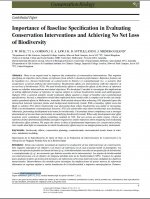Importance of Baseline Specification in Evaluating Conservation Interventions and Achieving No Net Loss of Biodiversity
By Joseph W. Bull, A Gordon, E. A. Law, K.B. Suttle, E. J. Milner-Gulland - Department of Life Sciences, Imperial College London, School of Global, Urban and Social Studies, RMIT University, Melbourne, Environmental Decisions Group, School of Biological Sciences, University of Queensland, Brisbane, Department of Life Sciences & Grantham Institute for Climate Change, Imperial College London, Department of Life Sciences, Imperial College London View PublicationThere is an urgent need to improve the evaluation of conservation interventions. This requires
specifying an objective and a frame of reference from which to measure performance. Reference frames can be baselines (i.e., known biodiversity at a fixed point in history) or counterfactuals (i.e., a scenario that would have occurred without the intervention). Biodiversity offsets are interventions with the objective of no net loss of biodiversity (NNL). We used biodiversity offsets to analyze the effects of the choice of reference frame on whether interventions met stated objectives. We developed 2 models to investigate the implications of setting different frames of reference in regions subject to various biodiversity trends and anthropogenic impacts. First, a general analytic model evaluated offsets against a range of baseline and counterfactual specifications. Second, a simulation model then replicated these results with a complex real world case study: native grassland offsets in Melbourne, Australia. Both models showed that achieving NNL depended upon the interaction between reference frame and background biodiversity trends. With a baseline, offsets were less likely to achieve NNL where biodiversity was decreasing than where biodiversity was stable or increasing. With a no-development counterfactual, however, NNL was achievable only where biodiversity was declining. Otherwise, preventing development was better for biodiversity. Uncertainty about compliance was a stronger determinant of success than uncertainty in underlying biodiversity trends. When only development and offset locations were considered, offsets sometimes resulted in NNL, but not across an entire region. Choice of reference frame determined feasibility and effort required to attain objectives when designing and evaluating biodiversity offset schemes. We argue the choice is thus of fundamental importance for conservation policy. Our results shed light on situations in which biodiversity offsets may be an inappropriate policy instrument.

